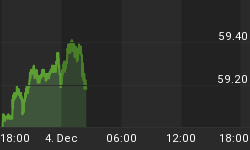As this headline from the Wall Street Journal shows, inflation pressures are just beginning to be recognized by investors.
Figure 1. Headline WSJ 
My composite indicator, which is constructed from the trends in crude oil, gold, and yields on the 10 year Treasury and which is a gauge of inflationary pressures, has been at extreme levels for the past 12 weeks. The indicator is shown in figure 2, a weekly chart of the SP500. When the indicator is at such extremes, this is a headwind for equities. However, for the past 3 months while the indicator was at an extreme level, the SP500 rose about 5%. This is not the average expected outcome but certainly within the realm of possible outcomes when the indicator is at an extreme level.
Figure 2. $INX/ weekly
In any case, the indicator is no longer extreme as gold and crude oil have come down in price over the past couple of weeks. So what was a concern of mine several months ago is the "market's" concern this week. The fact that inflationary pressures are subsiding is a positive forthe equity markets especially once the overbought conditions are cleared.















